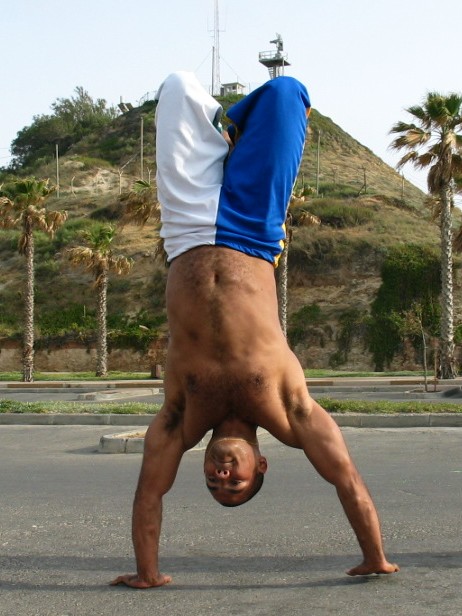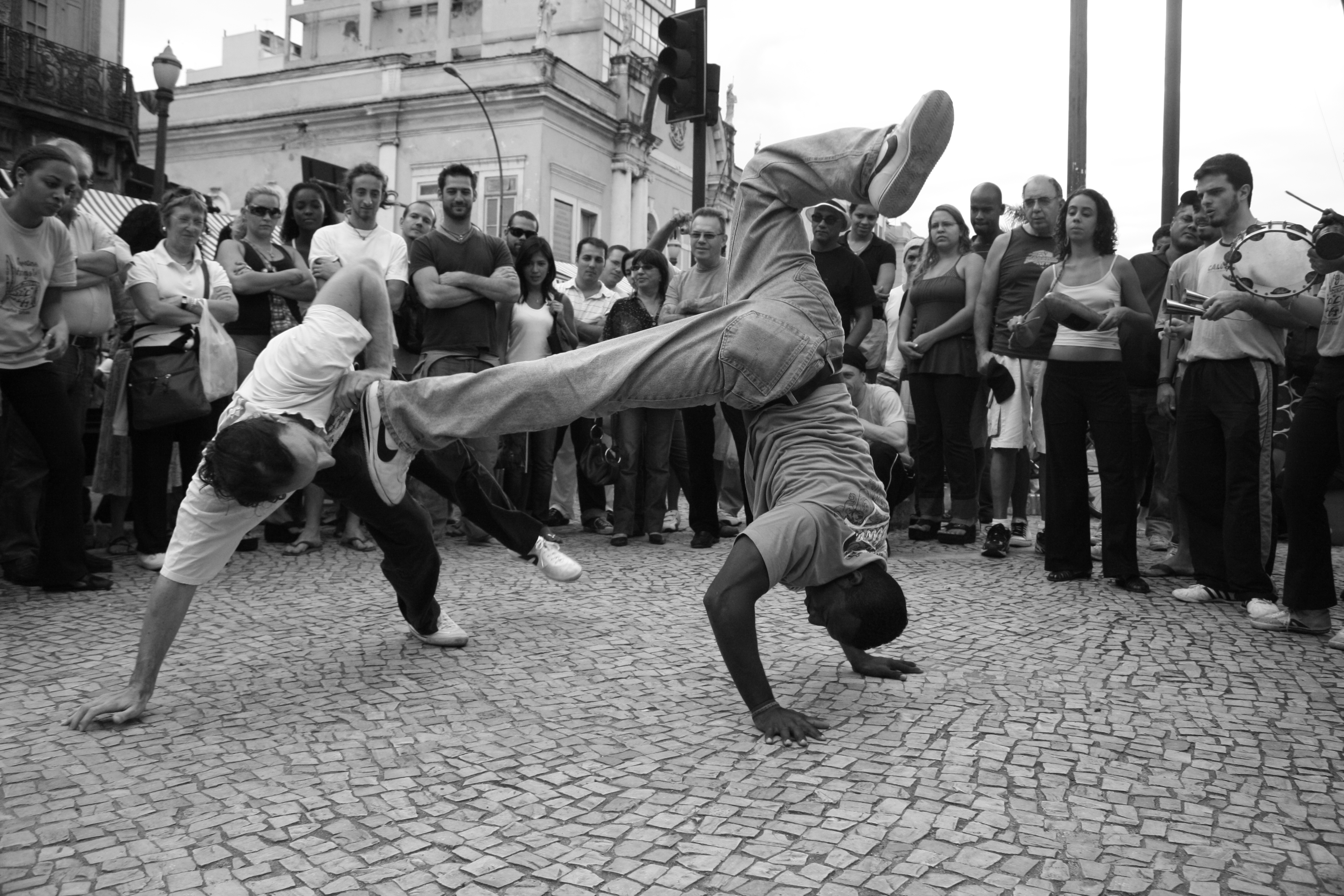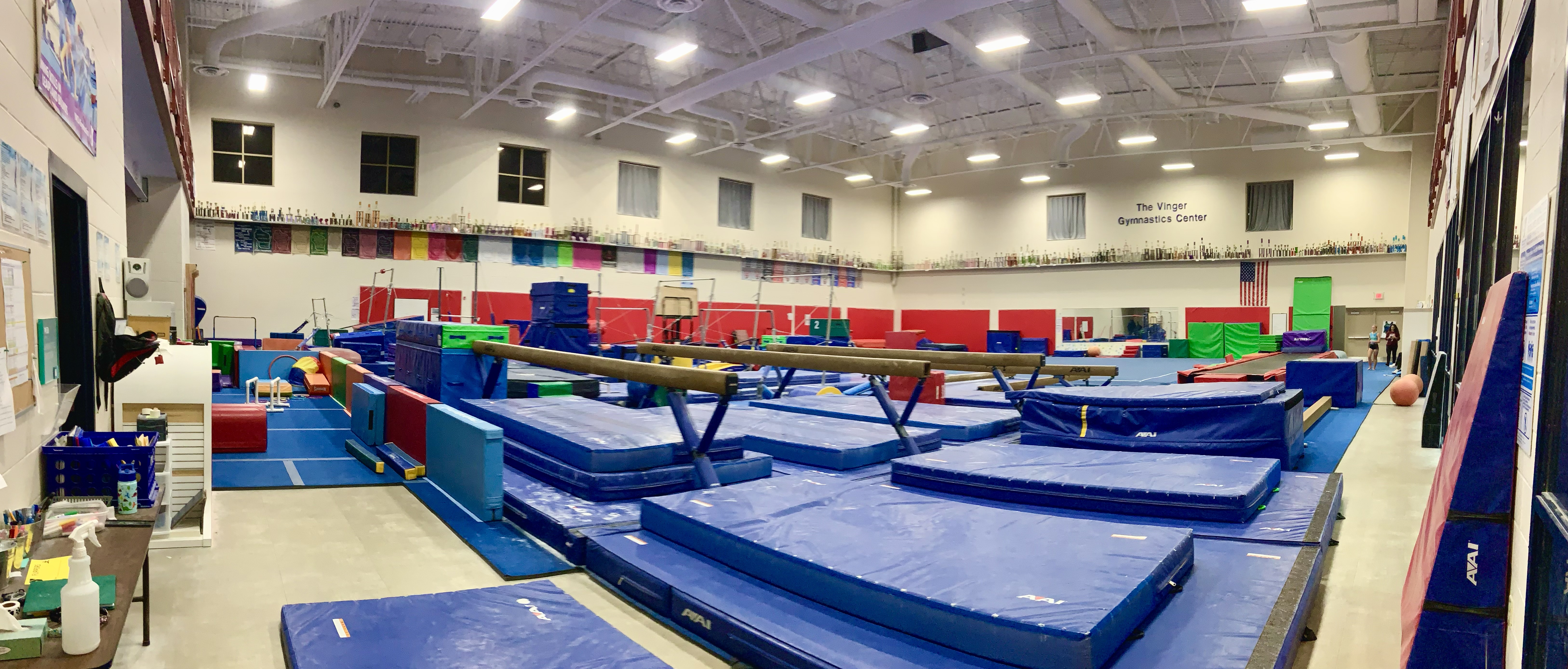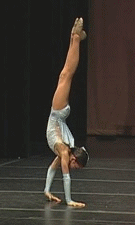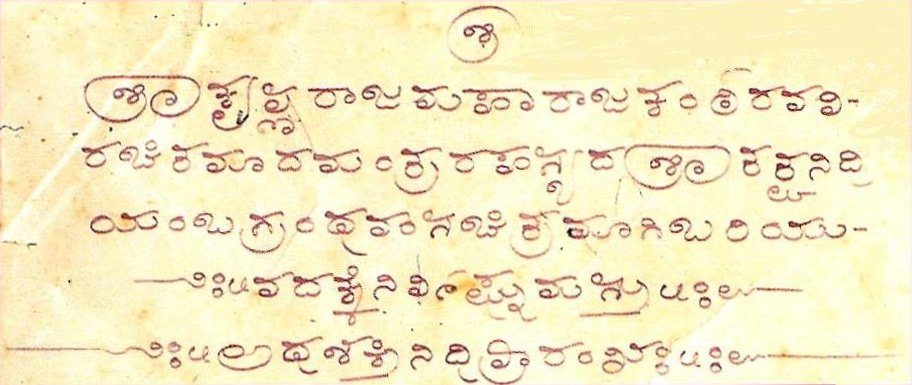|
Handstand
A handstand is the act of supporting the body in a stable, inverted vertical position by balancing on the hands. In a basic handstand, the body is held straight with arms and legs fully extended, with hands spaced approximately shoulder-width apart and the legs together. There are many variations of handstands, all of which require the performer to possess adequate balance and upper body strength. Kinematics Handstands use the wrist flexor muscles as well as the anterior deltoid, pectoralis major, latissimus dorsi, biceps brachii, and trapezius descendens. It is considered demanding in terms of both the muscle and joint requirement. According to a 2017 study most handbalancers use wrist movement to maintain balance in a handstand. Another study found that handbalancers who were also expert gymnasts had better coordination than those at an intermediate level of gymnastics. More advanced practitioners also altered their center of pressure less to change the center of mass wh ... [...More Info...] [...Related Items...] OR: [Wikipedia] [Google] [Baidu] |
List Of Capoeira Techniques
The list of capoeira techniques includes kicks, headbutts, evasions, acrobatics and more. In capoeira, the main emphasis is normally placed on the interaction between kicks and evasions. Due to historical reasons, different capoeira groups use different names for the same techniques, or the same name for different techniques. Historical development Core techniques Mestre Pastinha considered the core techniques of the traditional capoeira to be the following: * ''cabeçada'' (headbutt) * ''rasteira'' (sweep) * ''rabo de arraia'' * ''chapa de frente'' (front push kick) * ''chapa de costas'' (back push kick) * ''Meia lua de frente, meia lua'' (crescent kick) * ''cutilada de mão'' (Knifehand strike, hand chop) It is documented that the majority of the core capoeira techniques, including ''rasteira'', ''rabo de arraia'', ''chapa de frente'', ''chapa de costas'', ''meia lua de frente, meia lua'', and many other distinct techniques such as scorpion kick (martial arts), scor ... [...More Info...] [...Related Items...] OR: [Wikipedia] [Google] [Baidu] |
Handstand Push-up
The handstand push-up (press-up) - also called the vertical push-up (press-up) or the inverted push-up (press-up), also called "commandos" - is a type of push-up exercise where the body is positioned in a handstand. For a true handstand, the exercise is performed free-standing, held in the air. To prepare the strength until one has built adequate balance, the feet are often placed against a wall, held by a partner, or secured in some other way from falling. Handstand pushups require significant strength, as well as balance and control if performed free-standing. Similar exercises The movement can be considered a bodyweight exercise similar to the military press, while the regular push-up is similar to the bench press. Muscles The primary muscles used in the handstand push-up are the anterior deltoid, middle deltoid, posterior deltoid, pectoralis major, upper trapezius, and triceps brachii The triceps, or triceps brachii (Latin for "three-headed muscle of the arm"), is a l ... [...More Info...] [...Related Items...] OR: [Wikipedia] [Google] [Baidu] |
Gymnastics
Gymnastics is a group of sport that includes physical exercises requiring Balance (ability), balance, Strength training, strength, Flexibility (anatomy), flexibility, agility, Motor coordination, coordination, artistry and endurance. The movements involved in gymnastics contribute to the development of the arms, legs, shoulders, back, chest, and Abdomen, abdominal muscle groups. Gymnastics evolved from exercises used by the Ancient Greece, ancient Greeks that included skills for mounting and dismounting a horse. The most common form of competitive gymnastics is artistic gymnastics (AG); for women, the events include floor (gymnastics), floor, vault (gymnastics), vault, uneven bars, and balance beam; for men, besides floor and vault, it includes still rings, rings, pommel horse, parallel bars, and horizontal bar. The governing body for competition in gymnastics throughout the world is the Fédération Internationale de Gymnastique (FIG). Eight sports are governed by the FIG, in ... [...More Info...] [...Related Items...] OR: [Wikipedia] [Google] [Baidu] |
Freeze (breakdance Move)
A freeze is a b-boying technique that involves halting all body motion, often in an interesting or balance-intensive pose, for a few seconds. It is implied that the position is hit and held from motion as if freezing in motion, or into ice. Freezes often incorporate various twists and distortions of the body into stylish and often difficult positions. Spins are often combined with freezes, and the spins are usually done in the form of highkicks. Various handstands ("inverts", "Nikes", and "pikes") can be frozen, and skilled breakers sometimes incorporate the technique of ''threading'' into handstands by forming a loop with one arm and leg, then "threading" the other leg in and out of the loop. Variants There are many different variations of freezes. A common naming convention categorizes freezes based on what part of the body is in contact with the ground. First Freezes were chin freaks, Tracks, Splits, deadman freeze, chairs. Thus a " headstand freeze" is done with only t ... [...More Info...] [...Related Items...] OR: [Wikipedia] [Google] [Baidu] |
Hand Walking
Hand walking is an unusual form of human locomotion in which a person travels in a vertically inverted orientation with all body weight resting on the hands. It can be executed with legs fully extended or with variations such as stag, straddle or front splits. Hand walking is performed in various athletic activities, including acro dance and circus acrobatics. Skills and technique Hand walking is a skill that relies on a prerequisite ability to perform handstands, which in turn requires adequate upper body pressing strength in the deltoids and triceps as well as a heightened sense of balance and spatial awareness. Because the body is inverted during hand walking, blood pressure in the brain is greater than normal. Hand walking often elicits automatic, alternating leg movements similar to upright bipedal locomotion. Research shows that these leg movements are caused in part by neural coupling between arm and legs. As with other physical skills, one must practice hand walking in ... [...More Info...] [...Related Items...] OR: [Wikipedia] [Google] [Baidu] |
Calisthenics
Calisthenics (American English) or callisthenics (British English) () is a form of strength training that utilizes an individual's body weight as resistance to perform multi-joint, compound movements with little or no equipment. Calisthenics solely rely on bodyweight for resistance, which naturally adapts to an individual's unique physical attributes like limb length and muscle-tendon insertion points. This allows calisthenic exercises to be more personalized and accessible for various body structures and age ranges. Calisthenics is distinct for its reliance on closed-chain movements. These exercises engage multiple joints simultaneously as the resistance moves relative to an anchored body part, promoting functional and efficient movement patterns. Calisthenics' exercises and movement patterns focuses on enhancing overall strength, stability, and coordination. The versatility that calisthenics introduces, minimizing equipment use, has made calisthenics a popular choice for encour ... [...More Info...] [...Related Items...] OR: [Wikipedia] [Google] [Baidu] |
Acro Dance
Acro dance is a style of dance that combines classical dance technique with acrobatic elements. It is defined by its athletic character, its unique choreography, which blends dance and acrobatics, and its use of acrobatics in a dance context. It is a popular dance style in amateur competitive dance as well as in professional dance theater and in contemporary circus productions such as those by Cirque du Soleil. This is in contrast to acrobatic, artistic and rhythmic gymnastics, which are sports that employ dance elements in a gymnastics context under the auspices of a governing gymnastics organization (such as FIG) and subject to a Code of Points. Acro dance is known by various other names including ''acrobatic dance'' and ''gymnastic dance'', though it is most commonly referred to simply as ''acro'' by dancers and dance professionals. Acro is an especially challenging dance style for dancers as it requires them to be trained in both dance and acrobatic skills. History Ac ... [...More Info...] [...Related Items...] OR: [Wikipedia] [Google] [Baidu] |
Capoeira
Capoeira () is an Afro-Brazilian martial art and game that includes elements of dance, acrobatics, capoeira music, music, and spirituality. It likely originated from enslaved Mbundu people, of the Kingdom of Ndongo, in present-day Angola. The Mbundu of Ndongo had a formal military in which soldiers were professionally trained for combat. When Mbundu people were captured and sold into the Atlantic Slave Trade, they would have brought these fighting abilities with them to Brazil, where it developed into Capoeira. It is known for its acrobatic and complex manoeuvres, often involving hands on the ground and inverted kicks. It emphasizes flowing movements rather than fixed stances; the ''List of capoeira techniques#Ginga, ginga'', a rocking step, is usually the focal point of the technique. Though often said to be a martial art disguised as a dance, capoeira served not only as a form of self defense, but also as a way to maintain spirituality and culture. Capoeira has been practic ... [...More Info...] [...Related Items...] OR: [Wikipedia] [Google] [Baidu] |
Kick (breakdance Move)
A kick is a b-boy move that generally constitutes a one-handed handstand with the legs and free arm in some stylish position. Kicks can be employed as freezes, in which case they are held as long as possible. Alternatively, they can be executed quickly and powerfully to impress onlookers. Kicks are often named after letters or symbols whose form they imitate. The hand used for the stand is the "standing hand" and the leg on the same side of the body is the "standing leg." The other pair of appendages are the "free" hand and leg. Kicks are scored as footwork/legwork in the sport."WDSF Breaking: Rules and Regulations Manual", World DanceSport Federation The World DanceSport Federation (WDSF), formerly the International DanceSport Federation (IDSF), is the international governing body of dancesport and Para dancesport, as recognised by the International Olympic Committee (IOC) and the Inter ..., December 2023 (Version 6). Variants Some notable kicks include: *Airchair - Si ... [...More Info...] [...Related Items...] OR: [Wikipedia] [Google] [Baidu] |
Diving (sport)
Diving is the sport of jumping or falling into water from a Diving platform, platform or springboard, usually while performing acrobatics. Diving is an internationally recognised sport that is part of the Olympic Games. In addition, unstructured and non-competitive diving is a recreational pastime. Competitors possess many of the same characteristics as gymnastics, gymnasts and dancers, including strength, flexibility, kinaesthetic judgement and air awareness. Some professional divers were originally gymnasts or dancers as both the sports have similar characteristics to diving. Dmitri Sautin holds the record for most Olympic diving medals won, by winning eight medals in total between 1992 and 2008. History Antiquity In the Tomb of Hunting and Fishing there is a wall painting from around 530 - 500 BCE that shows a person climbing rocks towards a cliff face and a second person diving down the cliff face towards water. The Tomb of the Diver in Paestum, contains a fresco da ... [...More Info...] [...Related Items...] OR: [Wikipedia] [Google] [Baidu] |
Śrītattvanidhi
The ''Sritattvanidhi'' (, "The Illustrious Treasure of Realities") is a treatise written in the 19th century in the Mysore Palace, Karnataka on the iconography and iconometry of divine figures in South India. One of its sections includes instructions for, and illustrations of, 122 hatha yoga postures. Authorship The ''Sritattvanidhi'' is attributed to the then Maharaja of Mysore, Krishnaraja Woḍeyar III (b. 1794 - d. 1868). The Maharaja was a great patron of art and learning, and was himself a scholar and writer. Around 50 works are ascribed to him. The first page of the ''Sritattvanidhi'' attributes authorship of the work to the Maharaja himself: Martin-Dubost's review of the history of this work says that the Maharaja funded an effort to put together in one work all available information concerning the iconography and iconometry of divine figures in South India. He asked that a vast treatise be written, which he then had illustrated by miniaturists from his palace. ... [...More Info...] [...Related Items...] OR: [Wikipedia] [Google] [Baidu] |
Cheerleading
Cheerleading is an activity in which the participants (called cheerleaders) cheer for their team as a form of encouragement. It can range from chanting slogans to intense Physical exercise, physical activity. It can be performed to motivate sports teams, to entertain the audience, or for competition. Cheerleading routines typically range anywhere from one to three minutes, and contain components of Tumbling (gymnastics), tumbling, dance, List of cheerleading jumps, jumps, cheering, cheers, and List of cheerleading stunts, stunting. Cheerleading originated in the United States, where it has become a tradition. It is less prevalent in the rest of the world, except via its association with American sports or organized cheerleading contests. Modern cheerleading is very closely associated with American football and basketball. Sports such as association football (soccer), ice hockey, volleyball, baseball, and Scholastic wrestling, wrestling will sometimes sponsor cheerleading squad ... [...More Info...] [...Related Items...] OR: [Wikipedia] [Google] [Baidu] |
